Side Menu:
Fifth Officer Harold Lowe
- Ship's Officer
As with all his pre-White Star Line ships, the following information is based on Lowe's applications for First Mate and Master certiciates.
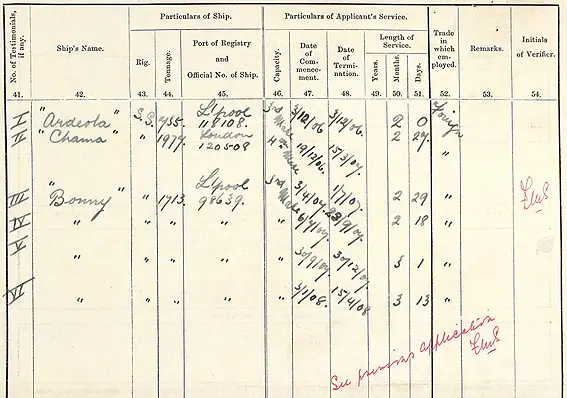
Harold Lowe's application form for his First Mate certificate. (Click image to enlarge)
1906 SS Ardeola
With his Second Mates certificate in hand, he had to wait a couple of months before finding the first ship that would allow him an officer's rank - and according to later documentation that ship was the SS Ardeola, a Liverpool registered ship (118108) a 755 ton steel Screw cargo ship built by Caledon Shipbuilding & Engineering Co. Ltd., Dundee in 1904 and owned by Ardeola S.S. Co. Ltd. otherwise known as the Yeoward Bros, Liverpool. (clydeships.co.uk/). It cost £22,500.00 (Friends of Dundee City Archives.)
Lowe signed-on on the 3rd of October 1906 for 2 months on foreign trade to the Canary Islands, in the role of Third Officer, returning on the 3rd of December 1906.
1906 SS Charma
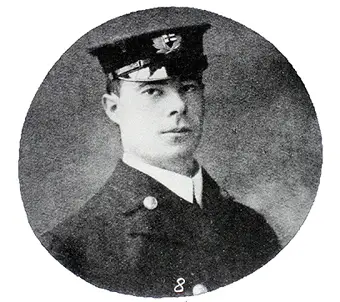
Harold Lowe in his Elder Dempster officers uniform.
(Click image to enlarge)
Lowe soon found another position -albeit Fourth Officer- on an Elder Dempster ship on the West African trade. The cargo ship was the SS Charma, at 1979 tonnes, a steel cargo ship registered to London (120508), at 350.4 x 48.3 x 20.5ft, launched in 1905 by the Palmers' Shipbuilding & Iron Co Ltd, in Jarrow (tynebuiltships.co.uk). According to Lowe's documents he joined on the 19th of December 1906 and worked aboard her as Fourth Mate for 2 month and 27 days until the 15th of March, 1907.
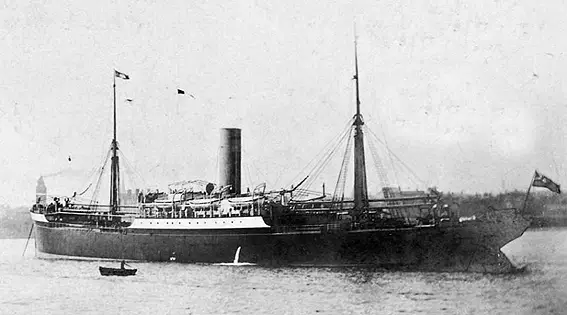
The SS Charma - Lowe worked aboard this cargo ship for two and a half months.
(Source: tynebuiltships.co.uk)
1907 SS Bonny
Sticking with the Elder Dempster line, his next ship was the SS Bonny, listed as 1713 tonnes, Liverpool registered (98639) also on the West African trade service. A steam cargo ship, she was much older than the Charma, built in 1891, with 1 triple expansion engine, single shaft, 1 screw that could manage 10.5 knots ( https://www.wrecksite.eu/wreck.aspx?13767)
Lowe was to stay with the SS Bonny for 4 voyages, although now at the rank of Third Mate, between the 3rd of March 1907 and the 15th of April 1908.
|
SS Bonny |
03/04/07 - 01/07/07 |
2 months, 29 days |
|
SS Bonny |
06/07/07 - 23/9/07 |
2 months, 18 days |
|
SS Bonny |
30/09/07 - 30/12/07 |
3 months, 1 day |
|
SS Bonny |
3/1/08 - 15/4/08 |
3 months, 13 days |
First Mate application
No doubt eager for promotion, on the 20th of July 1908 Lowe sat for his First Mate certificate, but as with his Second Mate exam, he failed on first attempt, this time in "Navigation." Undeterred, he sat the exam again exactly 7 days later on the 27th, and this time passed.
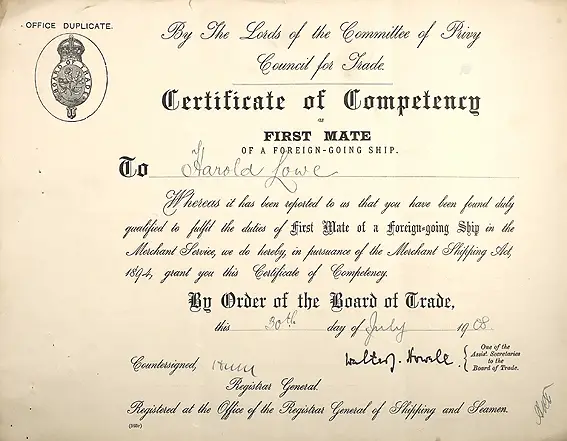
Lowe's First Mate Board of Trade Certificate.
1908 SS Madeira
With a new qualification in hand, Lowe returned to the Elder Dempster Line, this time joining the SS Madeira in the capacity of Second Officer on the West African service, on the 9th of September 1908, until the 2nd of December 1908, a total of 2 months, 24 days. His documents do not list the ship details but according to The Ships List the SS Madeira was built in 1884 and was 1,773 tons. (https://www.theshipslist.com/ships/lines/Elder_Dempster.shtml). It measured 300.0 x 36.2 x 19.9ft and is described as "compound steam, HP 199" and capable of 10 knots, along with 26 first class passengers, and 4 second (THE HISTORY OF ELDER DEMPSTER, http://www.rakaia.co.uk/).
According to research by Inger Sheil, Lowe also was "called upon to serve in the giddy heights of chief officer" during this voyage. (Titanic Valour: The Life of Fifth Officer Harold Lowe By Inger Sheil).
1908 SS Oron
His next Elder Dempster ship was the considerably larger SS Oron, built in 1898 and 3,170 tons (https://www.theshipslist.com/ships/lines/Elder_Dempster.shtml) It measured 345.0 x 42.2 x 23.0 and was also capable of 12 knots and could take 68 First and 20 Second passengers. (THE HISTORY OF ELDER DEMPSTER, http://www.rakaia.co.uk/)
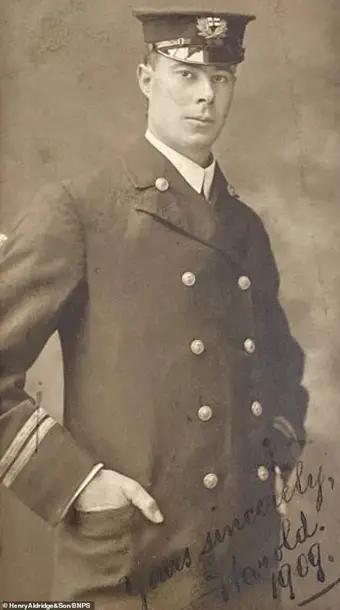
Lowe photographed in 1909 in his Elder Dempster
officers uniform. Photograph: Henry Aldrige & Sons
(Click to enlarge)
Lowe worked aboard her from the 17th of December 1908 until the 26th of march 1908 a total of 3 months and 10 days. According to Inger Sheil, the "new ship promised more comfort as she was fitted with electric lights and refrigeration, unlike the Madeira, and had plenty of salt beef carried in casks of brine and two pigs for fattening up during the voyage" (Titanic Valour: The Life of Fifth Officer Harold Lowe by Inger Sheil).
There is a seeming gap in Lowe's career at this point - between signing off on the 26th of March 1908 and his next ship which began on the 1st of June 1909 - more than a year inbetween. There is no note in his documents to explain this. However, we do know that one reason could have been the health of his mother, as back home tragedy struck on the 21st of March 1909 when Lowe's mother Harriet had a stroke, fell into a coma and then died.
1909 SS Addah
Lowe's time on the African service continued for the next two years, in this case aboard the SS Addah.
The Addah was also owned by the Elder Dempster Line and built in 1905 by Palmer & Co.; 4,397 tons; 350x48.3x20.7 ft.; 478 n.h.p.; 11.5 knots; triple expansion engine ( https://www.wrecksite.eu/wreck.aspx?85762) and was 3,149 tons (https://www.theshipslist.com/ships/lines/Elder_Dempster.shtml). It could additionally take 10 passengers (THE HISTORY OF ELDER DEMPSTER, http://www.rakaia.co.uk/)
Lowe would work aboard the Addah as its Second Officer for a total of 4 voyages:
|
Vessel |
From |
To |
|
SS Addah |
01/06/1909 |
09/09/09 |
|
SS Addah |
22/09/09 |
22/12/09 |
|
SS Addah |
15/1/10 |
15/4/10 |
|
SS Addah |
07/05/10 |
14/08/10 |
Masters Certificate
Back in Liverpool, Lowe sat for his Masters Certificate on the 26th of October 1910. In keeping with his failure on first attempt of his previous certificates indeed he failed again, this time it noted as "Navigation (Ship's Business)." On the 7th of November 1910, he resat the examination and passed, with a certificate issued in Liverpool on 12th of November 1910.
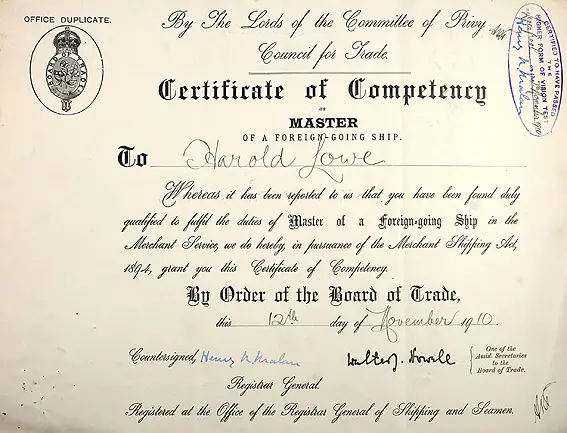
Master's Board of Trade Certificate.
Once again his qualification made the local news, with The Cambrian News and Merionethshire Standard reporting the following:

18 Nov 1910, The Cambrian News and Merionethshire Standard
(Credit: Cambrian News Ltd.)
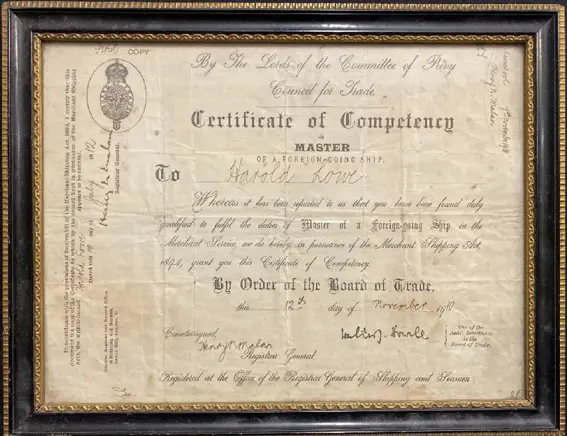
Lowe had his Masters certificate framed. Image: Henry Aldridge & Son.
(Click image to enlarge)
SS Zaria
Armed with his Masters Certificate, Lowe had one more voyage on the West African service - this time on the SS Zaria, a 1904 ship built by the Clyde Shipbuilding & Engineering Co. Ltd., Port Glasgow, 2023 tons, and measuring 350.6 ft x 48.5 ft x 19.7 ft and capable of 13 knots (http://www.clydeships.co.uk/view.php?ref=4374#v).
Lowe worked aboard the SS Zaria between the 10th of December and the 18th of March 1911. In April 1911, he was about to begin working for a different line: White Star.
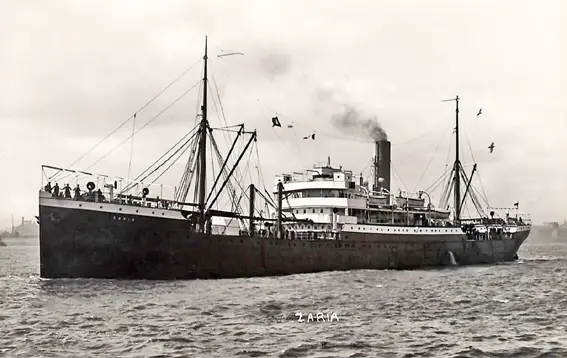
Lowe's last ship before joining the White Star Line - the SS Zaria.
Image: clydeships.co.uk (Click image to enlarge)
White Star Line - A "Hawsepiper"
Lowe officially joined the White Star Line on 8th of April 1911, according to his Record of Service in Company, which also notes "None" under the section in apprenticeships. This makes Lowe what is known informally as a "Hawsepiper" or "Hawsepipe Officer" or "coming up through the hawsehole - a term used to refer to a merchant ship's officer who began as an unlicensed merchant seaman and did not attend a traditional maritime college or academy to earn an officer's license and hence taking an untraditional route. The term comes from the ship's hawsepipe which is the pipe that passes through the bow section of a ship that the anchor chain passes through. So a "Hawsepiper" refers to climbing up the hawsepipe, a nautical metaphor for climbing up the ship's rank structure via an untraditional route.
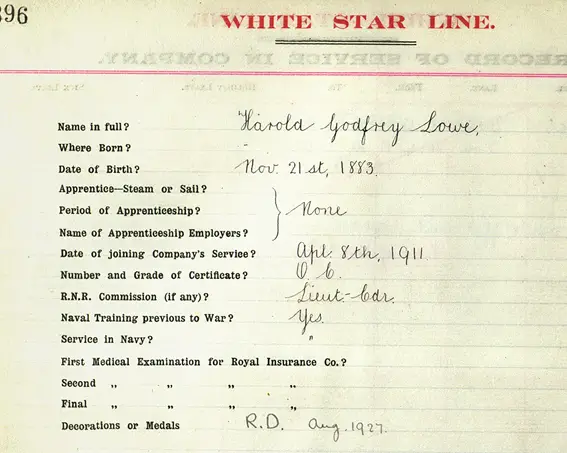
Lowe's White Star Line record shows "None" under apprenticeship.
His White Star Line Service record, that contains two possible errors:
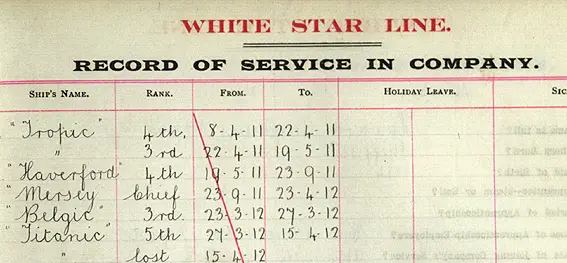
Lowe's White Star Line Service record, until Titanic.
1911 SS Tropic
Lowe began working for the White Star Line on the 8th of April 1911 and then signed on as Fourth Officer of the SS Tropic. According to crew agreement documents, on the 22 April 1911 the original Third Officer, Billiald, was transferred to another company ship, and Lowe was “promoted to 3rd mate @ £8 per month” with H Solomon signing on as the new Fourth Mate. The voyage to Australia took a total of five months, returning on the 19th of September 1911. (Tropic crew agreements courtesy of Inger Sheil)
Built by Harland and Wolff in Belfast, the SS Tropic was launched and completed in 1896, (Reg Number:105368) and was a steel steamship of 3630grt, 2340nrt, 350.0 x 47.0 x 17.2ft, single screw and capable of 11 knots. She entered service in 1897 (http://www.tynebuiltships.co.uk/)
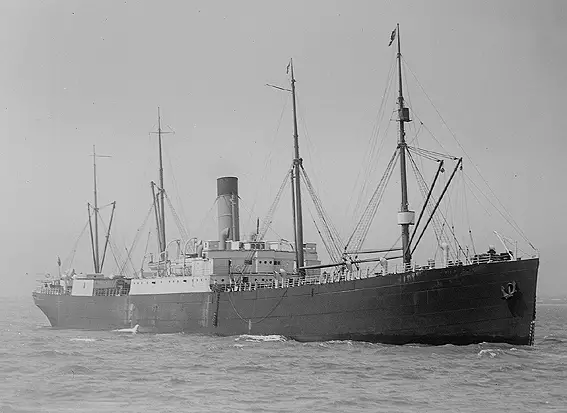
Lowe's first White Star Line ship was the SS Tropic, to Australia. Image: Allan C. Green/State Library of Victoria (Click image to enlarge)
Haverford and Mersey Discrepancies
Lowe's Navy service record lists him as signed onto to the Tropic until the 19th of September 1911. However his White Star Line record (above) has him aboard the Haverford as 4th officer during the latter half of this time period, specifically 19.5.11 - 23.9.11. So which is to be believed?
Interestingly, Lowe's Navy Service record completely omits any reference to Titanic and indeed his record seems to primarily date from July 1912 -post-Titanic. However, according to his White Star service record he is listed aboard the Haverford - but White Star did not own the Haverford in 1911 - it was run by the American Line from 1901 - 1921, although still under the IMM (International Mercantile Marine Company) umbrella, who also owned White Star (and David Blair sailed on her in 1919 as Chief Officer). It was purchased by the White Star Line in 1921. So unless Lowe was working aboard an American Line ship, it seems doubtful. Not to mention, critically, the crew agreement for his five month voyage aboard the Tropic lists him from 22 April 1911 – 19 September 1911 - which aligns with his Navy record.
His next ship, also according to his White Star Service Record was the Mersey, for which he is listed as, surprisingly, Chief Offcer, from 23.9.11 - 23.3.12.
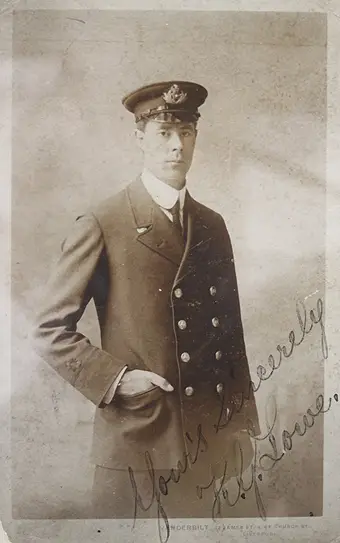
A young looking Lowe in his White Star uniform,
signed "H.G.Lowe". Photograph: Henry Aldridge & Sons.
(Click image to enlarge)
The Mersey was a three masted, 1,829 ton iron-hulled sailing ship. In 1908 the White Star Line purchased the ship for training 60 cadets making six voyages to Australia as a White Star training ship, traveling around the Cape of Good Hope outbound and Cape Horn inbound. The ship is not listed in Lowe's Navy records and most importantly, the crew agreement for the Belgic specically shows him aboard that vessel 23 September 1911 – 21 February 1912.
According to the The Times (London), 21 August 1908:
The Mersey was originally designed for carrying passengers. Her dimensions are---length, 271ft.; beam, 39ft.; tonnage, 1,829; and she is classed 100 A at Lloyd's. She is one of the finest type of British built sailing ships, and in rig she is an ideal craft for the purpose of training sailors, for she carries everything to stern sails. She has been specially fitted and altered to meet the requirements in view. There is excellent living accommodation for the cadets 'tween decks, and the school room is a spacious cabin on the main deck. In addition to obtaining practical experience in working a ship at sea, the boys will continue their general education, and will receive instruction in navigation, nautical astronomy, compass deviation, meteorology, marine surveying, charts, ship construction, stowage and assortment of cargo, care and management of boats, naval architecture,outfit and measurement of boats, charter parties, rudiments of marine engineering, and other branches of seamanship.
And there are further Titanic connections to this ship. Titanic researcher Gael Bordethad noted that Henry Wilde, who would become Titanic's Chief Officer, may have commanded the Mersey for a month in 1908. But more importantly, the Mersey had been Herbert Pitman's (Titanic's Third Officer) first ship as an apprenticeship from the 19th of April 1895, listed as an Able-Bodied sailor until the 18th of April 1899.
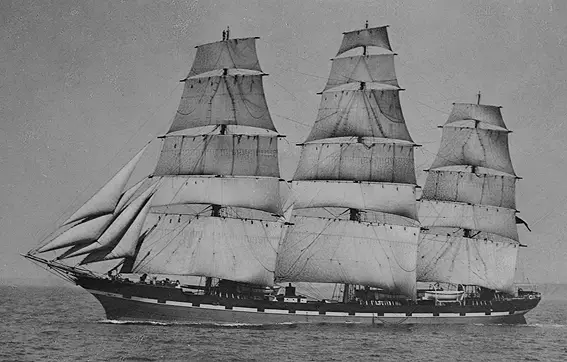
The full rigged ship Mersey in full sails. Credit: Allan C. Green/State Library of Victoria. (Click image to enlarge)
The Navy records and crew agreements reveal that the listing of the Haveford and Mersey as most likely a book keeping error. Not to mention, according to Lowe's testimony on day 5 of the United States Inquiry, he only mentions two White Star ships prior to Titanic - "I was third on the Tropic and I was third on the Belgic." (US Inquiry, Day 5) He does not mention the Haverford or the Mersey.
1912 SS Belgic
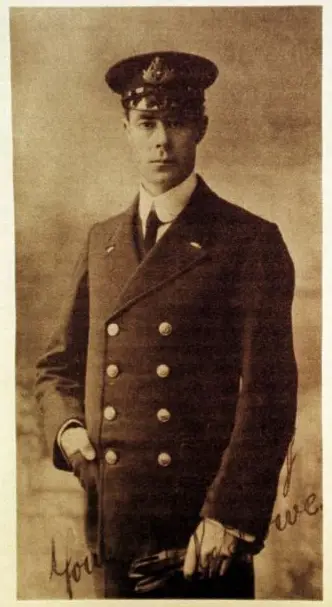
Lowe in his White Star officers uniform, holding
a pair of gloves.
On the 23rd of September 1912 he returned to the Australian service aboard the Belgic according to the crew agreement, until the 21 February 1912.
The SS Belgic had been purchased by the White Star Line from the Red Star Line on the 30th of August 1911 and renamed from Mississippi to Belgic, her maiden voyage for White Star took place from the 25th September 1911 and after 30 crew deserting ship causing some delay finally departed Australia for England on the 22nd of December 1911. Her second voyage took place on the 27th of March 1912 - the very day that Lowe signed on to Titanic. (whitestarhistory.com/belgic3)
By way of confirmation, Inger Sheil's book, Titanic Valour, also lists Lowe as Third Officer aboard the SS Belgic from the 22nd of September 1911 until the 21st of February 1912.
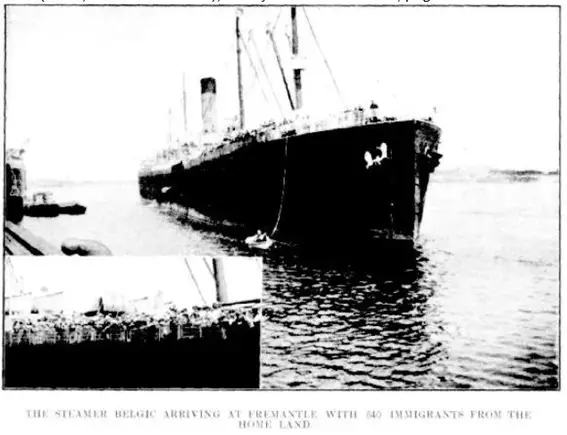
The SS Belgic arriving in Freemantle, Australia, 6 December 1912. (Source: The Belgic, Part 1 - A Passenger List and a Tale of Two Ships the Western Mail (Perth, Western Australia)
On the 27th of March 1912 Harold Lowe signed on to what would be his most famous - or maybe infamous - ship: the Titanic.
And it was certainly a step up from the Belgic, which had been built in Camden, New Jersey, United States in 1902, and had a gross tonnage of 8,100 tons, rigged as a four-masted schooner, but with two sets of triple expansion engines. By comparison, the Titanic was 46,000 gross tons - nearly 6 times that of the Belgic!
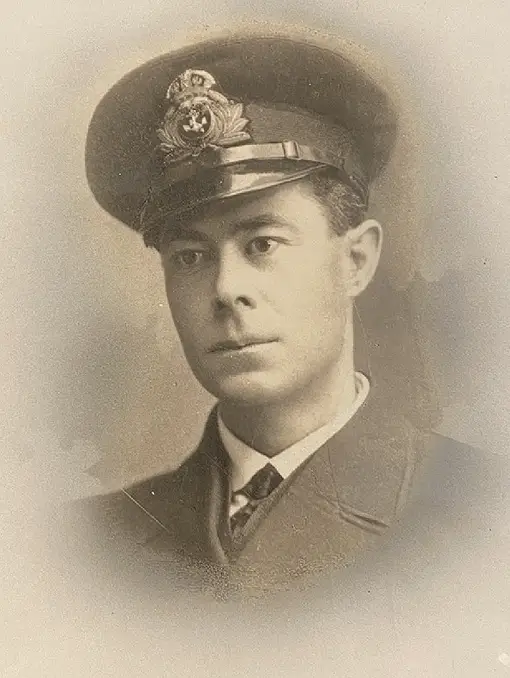
Harold Lowe in his RNR uniform (Henry Aldridge & Son)
See also...
Next... Titanic